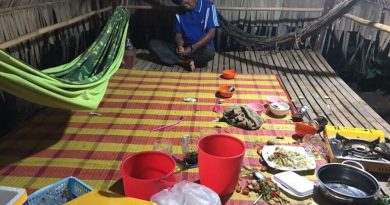This Week In Cambodian History- January 2-7
On January 3, 1992, the U.S. embargo was lifted, normalizing economic relations with Cambodia. The U.S. also ended blanket opposition to lending to Cambodia by international financial institutions.
On January 3, 2014, armed forces fired live rounds after protests turned violent on Veng Sreng St in Phnom Penh. Five died and many more were injured.
On January 3, 2020, a construction project in Kep collapsed, killing 36 people.

On January 5, 1642, Prince Outey, who was serving as regent, was assassinated by Ponhea Chan. Chan was supposed to be king after the death of Ang Tong Reachea (1608–1640), also known as Ponhea Nou, but forced to hand the crown to Outey’s son, Ang Non I (Batom Reachea). The king was then then captured and executed at Oudong. Ponhea Chan became king, under the name Ramathipadi I and later converted to Islam, taking the name Sultan Ibrahim.
On January 5, 1976, Khmer Rouge leader Pol Pot announces a new constitution, changing the name of Cambodia to Kampuchea and legalizing its Communist government. Khmer Rouge leaders congratulated Cambodians, especially workers and peasants, for their ‘participation in the national and people’s liberation war, and for sacrificing their lives, their properties, and their love for their children and spouses for the cause of military service without hesitation’.

On January 5, 1979, Pen Sovann became Secretary-General of the Kampuchean People’s Revolutionary Party.
On January 6, 1908, a novice monk died of bubonic plague near the Royal Palace. This was the first case since September 1907, and it had been thought the epidemic had been contained. The plague then spread to the royal court, killing a concubine and the potential heir to the throne, Prince Duong Mathura.
On January 6, 1979, the Việt Nam People’s Navy launched a naval landing aimed at capturing Kampong Som Port and Ream military port, eliminating Navy Division 164 and Border Guard Regiment 17 of the Pol Pot regime and destroy its southern defensive line.
Vietnamese forces from Việt Nam Navy’s Brigade 101 Naval Infantry attacked and occupied the beach at the foot of Tà Lơn Mountain (Bokor) Mountain in Kampot Province.

On January 6, 1978, an estimated 60,000 troops from the People’s Army of Vietnam (PAVN) withdrew from Cambodia after launching an attack on December 16, 1977. The PAVN had come to within 30 km of Phnom Penh, before moving back across the border. Despite being routed, Pol Pot ordered attacks on the Vietnamese to continue, and declared the event a victory. “our 6 January victory over the annexationist, Vietnamese aggressor enemy has given all of us greater confidence in the forces of our people and nation, in our Kampuchean Communist Party and our Kampuchean Revolutionary Army, and in our Party’s line of people’s war“. The PAVN would return a year later.
On January 7, 1973, two more Government positions in southern Cambodia were reported to be seriously threatened today and the battle continued for the battered market town of Tram Khnar. Military headquarters in Phnom Penh said that the villages of Thnal Totoeng and Svay Prey, about 30 miles south of the capital, were under serious threat. The villages, on the main highway south, came under heavy attack last night. Outside Tram Khnar, Government forces fought against mixed Cambodian and Vietnamese Communist units in rice fields today. The town itself, badly damaged in four days of fighting, was reported quiet as Communist snipers withdrew from buildings around the hurned‐out central market. (Reuters)
On January 7, 1979 the first units of an army of 100,000 Vietnamese regulars and a force of 20,000 Cambodians representing the Vietnamese-backed Kampuchea “Salvation Front” entered Phnom Penh and brought an official end to the three year, eight month and twenty day rule of Pol Pot’s Democratic Kampuchea.






